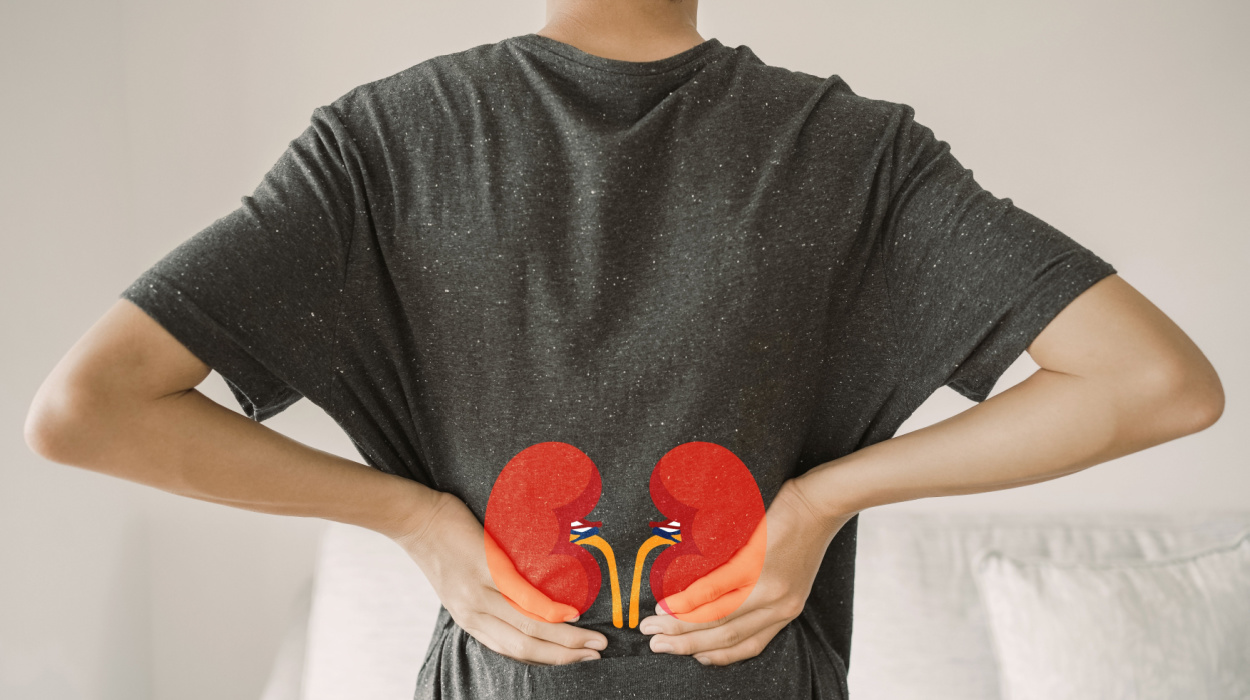Cancer of any type can be devastating, and kidney cancer is no different. Given the risks associated with cancer, it’s important to be aware of key facts and statistics related to it.
Below, find the top kidney cancer statistics for recent years. You’ll learn who kidney cancer affects, as well as how common this type of cancer is.
You’ll also learn about factors that increase your risk of renal cancer. Hopefully, this information will raise awareness of kidney cancer and preventive strategies.
Key Kidney Cancer Facts
- In 2023, an estimated 81,800[1] people in the United States will be diagnosed with kidney cancer.
- It is estimated that 14,890[1] deaths from kidney cancer will occur in the United States in 2023.
- Kidney and renal pelvis cancer represents 4.2%[1] of all new cancer cases in the U.S.
- The five-year survival rate for kidney cancer between 2013 and 2019 was 77.6%.[1]
Men of all races are more likely[1] than women to be diagnosed with or die from kidney cancer.
Kidney Cancer Statistics
How Common Is Kidney Cancer?
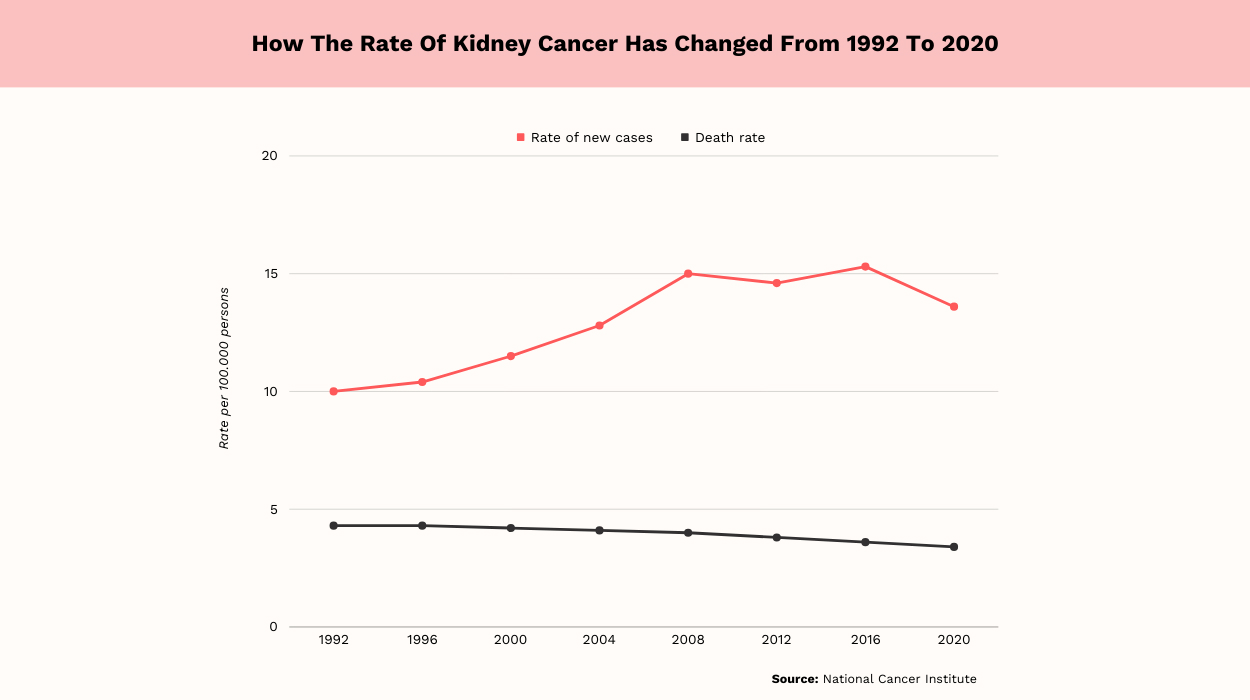
- In 1992, the rate of new cases, also called incidence rate, of kidney cancer was 10.0[1] per 100,000 people.
- As of 2020, the kidney cancer incidence rate was slightly higher than in 1992, at 13.6[1] per 100,000 people.
- The incidence rate peaked in 2019, with 15.7[1] new kidney cancer cases per 100,000 people.
- Kidney cancer deaths decreased from 4.3[1] per 100,000 in 1992 to 3.4[1] per 100,000 in 2020.
Since 1992, there has been an upward trend[1] in kidney cancer incidence. However, rates decreased[1] from 2019 to 2020 after peaking in 2019. Despite the upward trend in incidence, cancer death from renal cancer has decreased slightly[1] since 1992.
According to Dr. Kevin Huffman, Doctor of Osteopathic Medicine and board-certified bariatric physician, “We must acknowledge a troubling pattern that is emerging.” He says, “In my years practicing bariatric medicine and confronting numerous obesity-related conditions—such as diabetes and hypertension—I have witnessed a steady increase in patients also battling kidney cancer.”
Dr. Huffman further explains, “This observed rise stems from multiple factors. It owes not only to enhanced diagnostic modalities but also to lifestyle behaviors leading to both obesity and an escalated risk for cancer.
Who Gets Kidney Cancer?
Kidney Cancer Statistics By Age
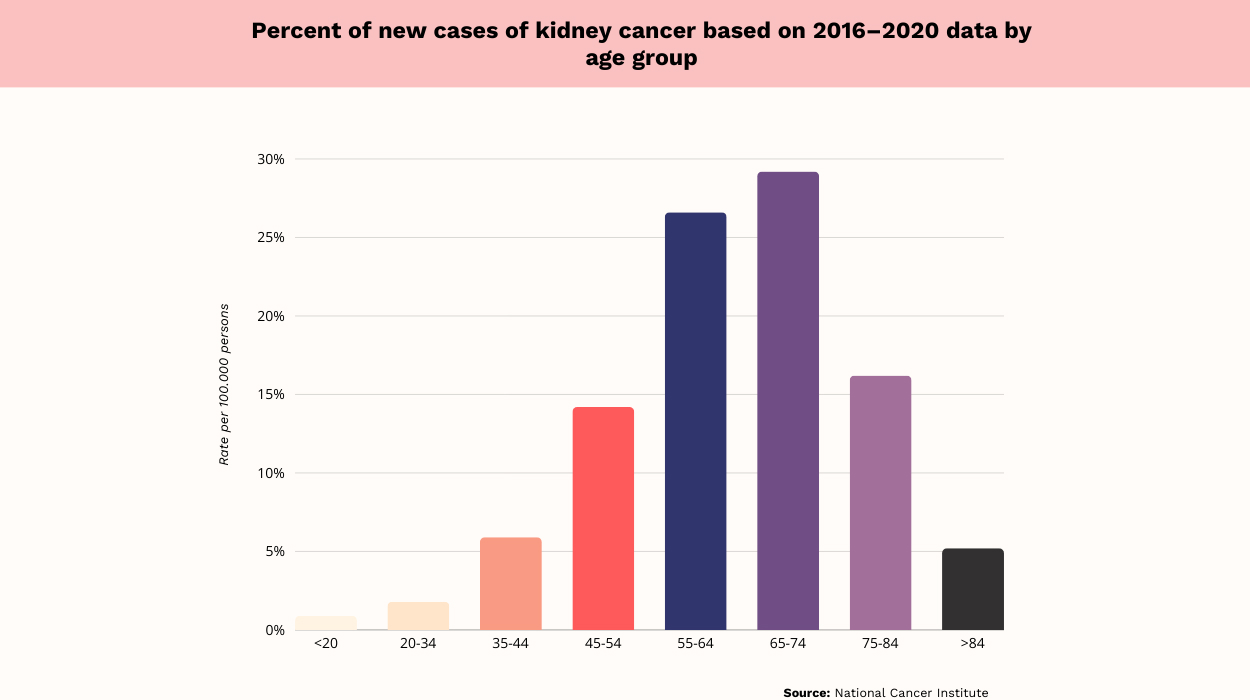
- People under 20 make up just 0.9%[1] of new cases of kidney and renal pelvis cancer.
- Kidney cancer incidence rates are also low in those aged 20-34. This age group is responsible for 1.8%[1] of new kidney cancer cases.
- Of all new kidney cancers, 5.9%[1] occur in those ages 35-44.
- Those aged 45-54 make up 14.2%[1] of incident kidney cancers.
- 26.6%[1] of new kidney cancer cases occur in those aged 55-64.
- The highest rate of incident kidney cancer is in the 65-74 age bracket, which comprises 29.2%[1] of new cases.
- 16.2%[1] of new kidney cancers occur in those aged 75-84, and 5.2%[1] occur in those older than 84.
It is uncommon for younger adults to be diagnosed with kidney cancer. Individuals under 20 and those 20-34 make up a small portion[1] of new cases of kidney cancer. Kidney cancer incidence rates are highest[1] among those 65-74, closely followed by those aged 55-64. Those over age 84 also make up a small portion[1] of new cases of kidney cancers.
Kidney Cancer Statistics By Race/Ethnicity & Sex
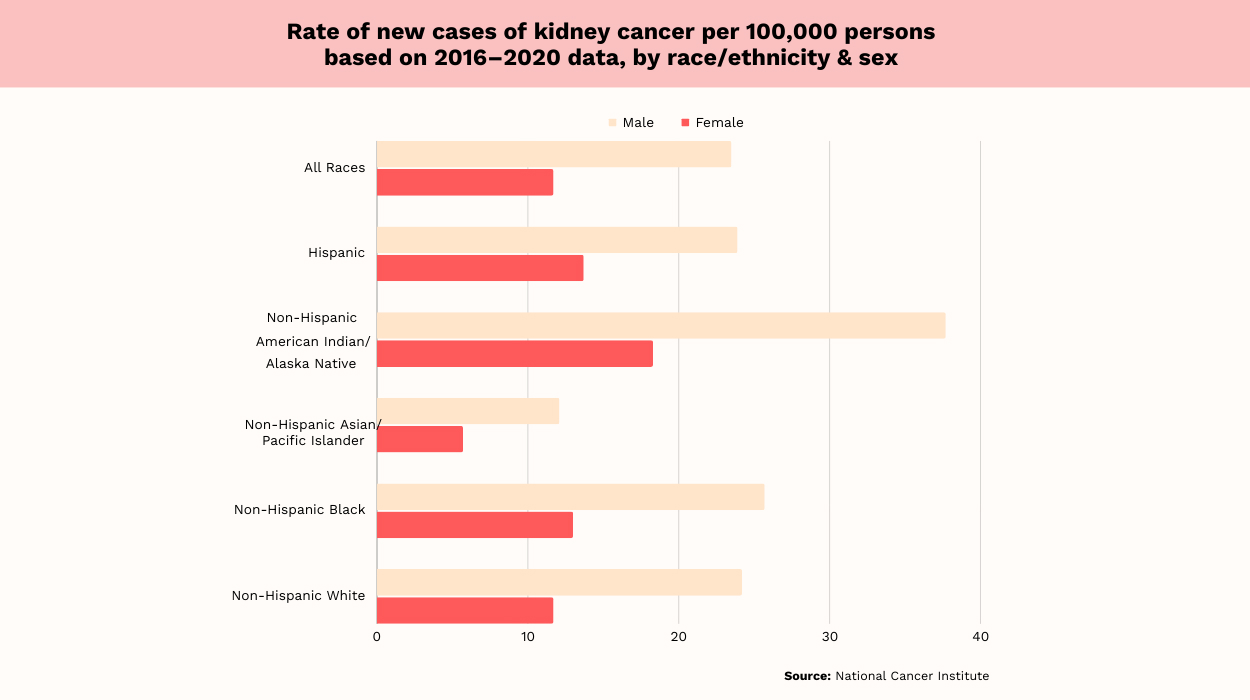
Kidney Cancer Death Rate
- Health statistics show that the kidney cancer incidence among all races is 23.5[1] per 100,000 men. For women, the incidence is 11.7[1] per 100,000 people.
- In Hispanic populations, the incidence is 23.9[1] per 100,000 men and 13.7[1] per 100,000 women.
- In non-Hispanic American Indian/Alaskan Natives, the incidence is 37.7[1] per 100,000 men and 18.3[1] per 100,000 women.
- The incidence of non-Hispanic Asian/Pacific Islanders is 12.1[1] per 100,000 men and 5.7[1] per 100,000 women.
- In non-Hispanic Blacks, the incidence is 25.7[1] per 100,000 men and 13.0[1] per 100,000 men.
- In non-Hispanic Whites, the incidence is 24.2[1] per 100,000 men and 11.7[1] per 100,000 women.
Kidney cancer incidence trends show that there is variation in new cases based on race/ethnicity. Men of all races are more likely[1] than women of all races to be diagnosed with kidney cancer. The highest incidence[1] in both men and women occurs in non-Hispanic American Indian/Alaskan Natives. The lowest rates[1] in both men and women are among non-Hispanic Asian/Pacific Islanders.
Percent Of Deaths By Age Group
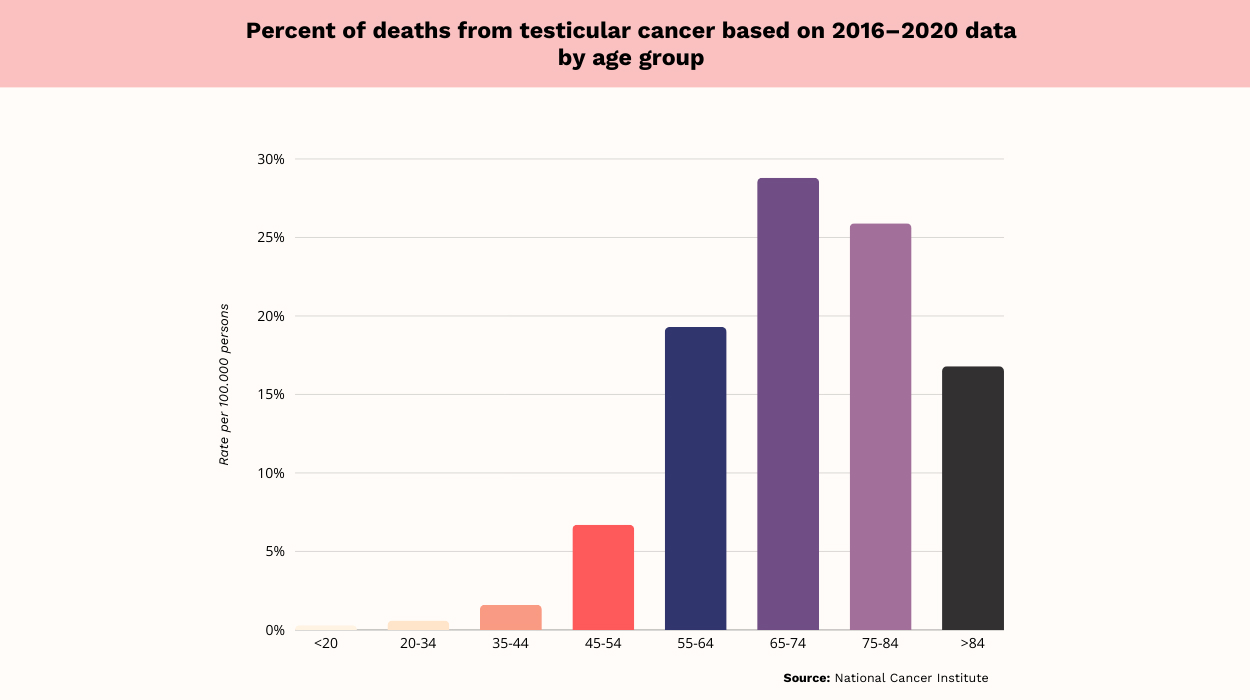
Mortality rates for kidney cancer are as follows in various age groups:
- Under age 20: 0.3%.[1]
- Ages 20-34: 0.6%.[1]
- Ages 35-44: 1.6%.[1]
- Ages 45-54: 6.7%.[1]
- Ages 55-64: 19.3%.[1]
- Ages 65-74: 28.8%.[1]
- Ages 75-84: 25.9%.[1]
- Over age 84: 16.8%.[1]
Mortality rates for kidney cancer are highest[1] in those aged 65-74 and lowest[1] in those under 20. The age bracket of 75-84 has the second highest[1] mortality rates, followed by ages 55-64.
There is a general trend of increasing[1] mortality rates from kidney and renal pelvis cancer with increasing age. However, after age 65-74, there is a decline[1] in death rates.
Death Rate By Race/Ethnicity & Sex
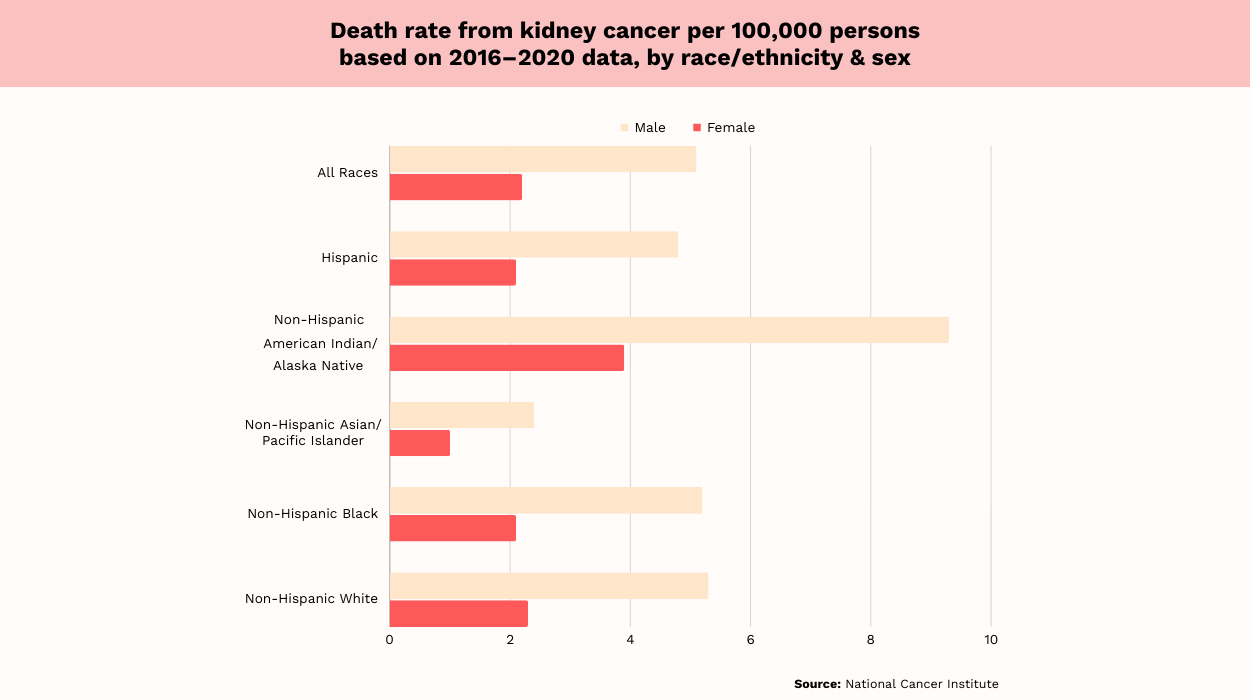
The death rate from kidney cancer per 100,000 men, based on race/ethnicity, is as follows:
- All races: 5.1.[1]
- Hispanic: 4.8.[1]
- Non-Hispanic American Indian/Alaskan Native: 9.3.[1]
- Non-Hispanic Asian/Pacific Islander: 2.4.[1]
- Non-Hispanic Black: 5.2.[1]
- Non-Hispanic White: 5.3.[1]
The death rate from kidney cancer per 100,000 women, based on race/ethnicity, is as follows:
- All races: 2.2.[1]
- Hispanic: 2.1.[1]
- Non-Hispanic American Indian/Alaskan Native: 3.9.[1]
- Non-Hispanic Asian/Pacific Islander: 1.0.[1]
- Non-Hispanic Black: 2.1.[1]
- Non-Hispanic White: 2.3.[1]
Among all races, the kidney cancer death rate is higher[1] in men than women. The lowest[1] death rate in both genders is among non-Hispanic Asian/Pacific Islanders.
The highest[1] mortality rate is in non-Hispanic American Indian/Alaskan Natives. This is true for both genders.
Kidney Cancer Survival Rate
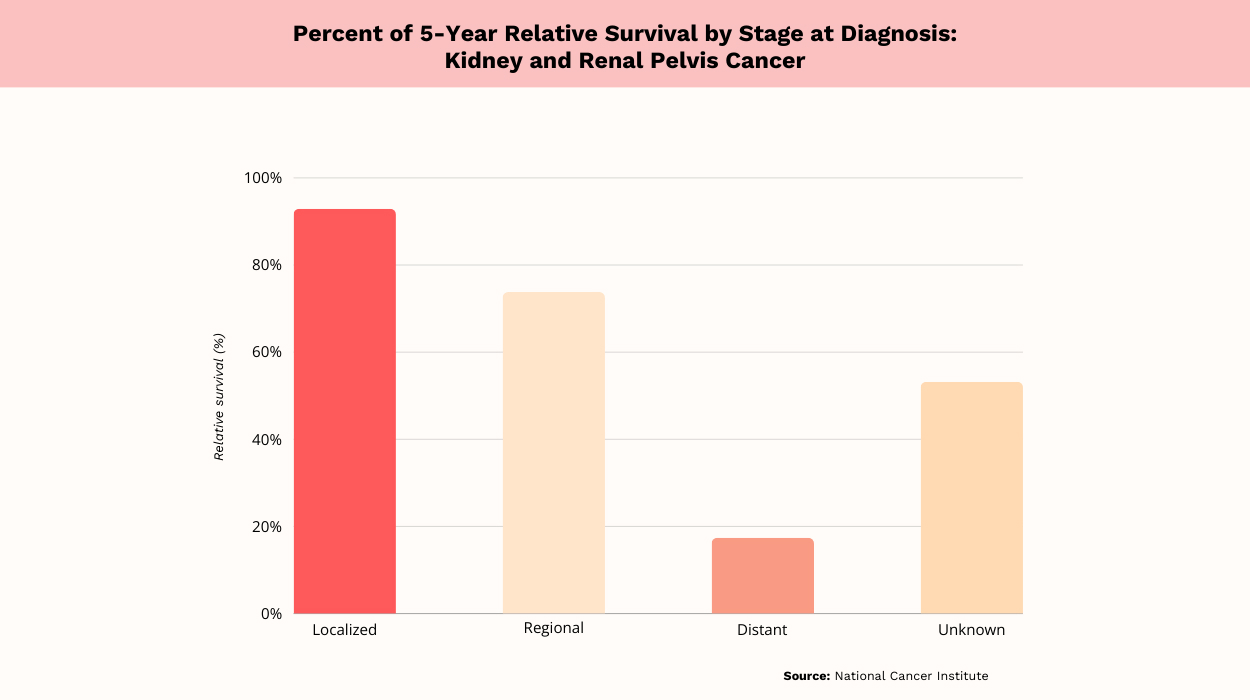
The 5-year relative survival rates for people diagnosed with kidney and renal pelvis cancer, based on the stage at diagnosis, are:
These numbers are based on the average five-year relative survival rate from 2013 to 2019.
Localized kidney cancer means that the cancer is confined to the kidneys. Regional cancers have spread to regional lymph nodes, and distant cases have metastasized. Localized cancers have the highest[1] 5-year survival rates, and distant cases have the lowest[1] survival rates.
Kidney Cancer Facts To Know
Beyond incident rates and variations based on race and gender, there are additional kidney cancer facts to know.
Number Of Annual Diagnoses
You might be wondering, “How common is kidney cancer?” According to SEER cancer statistics, an estimated 81,800[1] people will be diagnosed with kidney cancer in 2023. Kidney cancer diagnoses will account for 4.2%[1] of all new cancer cases.
Facts Related To Survival
According to survival statistics, the 5-year relative survival rate for kidney cancer was 77.6%[1] between 2013 and 2019. This does not consider the specific stage of kidney cancer.
Facts Related To Mortality
There will be an estimated 14,890[1] deaths from kidney cancer in 2023. Kidney cancer will be responsible for 2.4%[1] of cancer deaths.
Rankings Compared To Other Cancers
Kidney and renal pelvis cancer is the seventh[1] most common cancer type, based on incidence rates. Cancer types that are more common than kidney cancer include:[1]
- Female breast cancer.
- Prostate cancer.
- Lung and bronchus cancer.
- Colorectal cancer.
- Skin melanoma.
- Bladder cancer.
According to global data, kidney cancer is the 14th[3] most common cancer worldwide.
Temporal Trends
There have been slight increases in age-adjusted incidence of kidney and renal pelvis cancer. There was a 0.7%[1] increase in prevalence each year between 2010 and 2019.
Death rates declined slightly between 2011 and 2020. There was an average decline of 1.5%[1] each year during this time.
Global Trends
Global data on renal pelvis cancer shows 403,000[4] people are diagnosed with this type of cancer each year. This means that kidney cancer represents 2.2%[4] of all cancer diagnoses worldwide.
Global data also show that men are around 1.7 times[4] more likely than women to be diagnosed with kidney neoplasms. Furthermore, the global risk of kidney cancer diagnosis is 0.69%[4] in men and 0.35%[4] in women.
Finally, the global incidence is highest in North America, with an incidence of 10.9[4] per 100,000 people. The second-highest rates are in Western Europe, at 9.7[4] per 100,000. This is followed by Australia/New Zealand, at 9.6[4] per 100,000.
Symptoms Of Kidney Cancer
If you or someone you love is worried about kidney cancer, you probably want to know about the symptoms. The following symptoms[5] are common in kidney and renal pelvis cancers:
- Bloody urine.
- Lumps or swelling near the kidneys or abdomen.
- Persistent pain in the lower back or side.
- Recurrent fever.
- Frequently feeling tired.
- Lack of interest in eating.
- Losing weight without trying.
- Blockage in the bowels.
- Feeling generally unwell.
You may not always have signs if you’re developing kidney cancer. According to Dr. Atul K. Tandon, Ph.D.,a seasoned professional in Biotechnology, “One critical fact to know about kidney cancer is that it often doesn’t present with obvious symptoms in the early stages.” He further says, “It’s often discovered during routine health checks, thereby emphasizing the importance of regular medical screenings.
Kidney Cancer Risk Factors
Some people are at greater risk of kidney cancer than others. Some identified risk factors for kidney cancer include:[5]
- Overweight/obesity.
- Being a smoker.
- High blood pressure or the use of medications to treat hypertension.
- Long-term use of some pain medications.
- Long-term infection with hepatitis C.
- History of kidney stones.
- Having the sickle cell trait increases the risk of renal medullary carcinoma, a rare form of kidney cancer.
- Exposure to the chemical trichloroethylene.
How To Reduce Your Risk For Kidney Cancer
Lifestyle changes are important to reduce your risk of kidney cancer. Recommended changes include:[5]
- Avoid smoking, and make an effort to quit if you’re a current smoker.
- Maintain a healthy weight.
- Engage in regular exercise.
- Follow a healthy diet.
- Be careful about using chemicals, especially trichloroethylene, which you might be exposed to if you work with metals.
Dr. Huffman states, “My strongest advice—to mitigate the risk of kidney cancer—echoes preventive medicine principles.” He further states, “Maintaining a healthy body weight is crucial, as obesity escalates this risk; consequently, obese individuals must prioritize weight loss.”
Dr. Charles M. Carlsen, co-founder of DRSONO Medical, agrees with Dr. Huffman’s statements. “Regular physical activity and maintaining a healthy weight can lower kidney cancer risks,” he says. Dr. Carlsen adds, “A balanced diet rich in fruits, vegetables, and lean proteins can aid in weight management.”
Nutrition For Cancer Prevention
It’s important to understand the specific nutritional factors that reduce the lifetime risk of kidney cancer. Unfortunately, some foods may increase the risk of kidney cancer. For instance, alcohol and processed meat increase[6] cancer risk.
On the other hand, a healthy diet that prevents a person from accumulating excess body fat can reduce[6] the risk of cancer. Some general recommendations are to follow a diet rich in whole grains, legumes, fruits, and vegetables. People should also consume moderate amounts of meat, fish, and dairy.
At the same time, it’s important to limit alcohol and salty, processed foods to reduce cancer risk.
Kidney Cancer Diagnosis And Treatment
Kidney cancer is diagnosed[7] using procedures such as ultrasound or a CT scan to evaluate the abdomen and kidneys. Sometimes, a doctor will also perform a biopsy. This involves inserting a thin needle into the tumor, removing tissue, and then checking it for cancer.
Once a diagnosis is made, additional testing[7] is completed. This could include a chest x-ray, a CT scan, an MRI, or a bone scan to check if the cancer has spread. Once the stage of cancer is identified, treatment can begin.
Treatment Options
There are various treatment options[7] for kidney cancer. Patients may undergo surgery to remove part or all of the kidney. The kidney, the adrenal gland, and the lymph node are removed in the case of a radical nephrectomy.
If a person cannot undergo surgery, a doctor may perform[7] a procedure called arterial embolization to shrink the tumor.
Other treatment options include:[7]
- Radiation therapy to kill cancer cells.
- Chemotherapy uses drugs to stop cancer growth.
- Immunotherapy uses a patient’s own immune system to fight cancer.
- Targeted therapy is a modality used in advanced renal cell cancer to attack specific cancer cells with drugs.
Conclusion
Kidney cancer is a serious condition affecting many people in the U.S. Data show there will be an estimated 81,800[1] new cases of this cancer in 2023.
Specific risk factors, such as smoking and obesity, increase[5] the risk of kidney cancer. Certain groups are also more likely to be affected. For example, American Indians and Alaskan Natives have[1] the highest incidence rates, and they’re most likely to die.
Fortunately, you can take steps to manage kidney cancer risk factors. Changing your diet to promote weight loss will reduce your risk if you’re overweight. It’s also important to remain physically active, limit alcohol intake, and stop smoking if you’re a smoker.
Frequently Asked Questions
Whether kidney cancer is aggressive depends on the specific type. For instance, hereditary leiomyomatosis and renal cell carcinoma are considered[8] the most aggressive types.
More advanced stages of kidney cancer are associated with lower[1] survival rates. However, research[9] shows that survival rates for stage 4 cancers have improved recently.
Kidney cancer is most common[1] in men compared to women, non-Hispanic American Indian/Alaskan Natives, and those ages 65-74.
Whether kidney cancer spreads quickly depends on the type. It can spread quickly, but there is variation. Research suggests[10] that larger tumors are more likely to be metastatic, meaning they have spread.
 Evidence Based
Evidence Based
